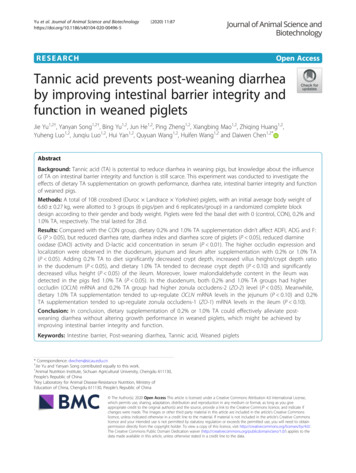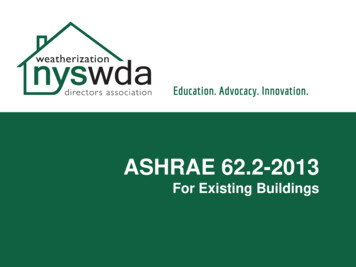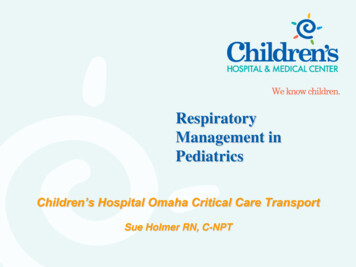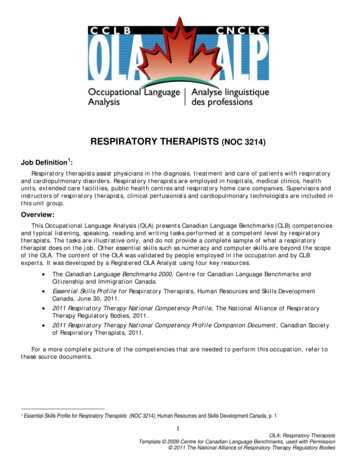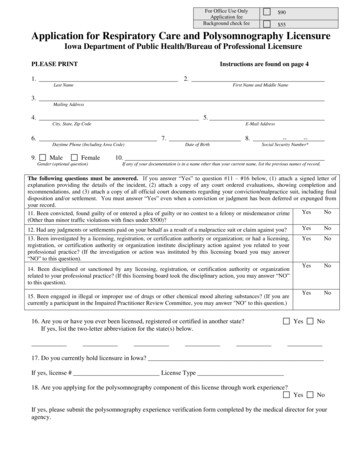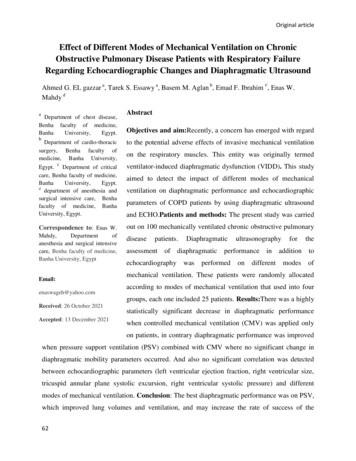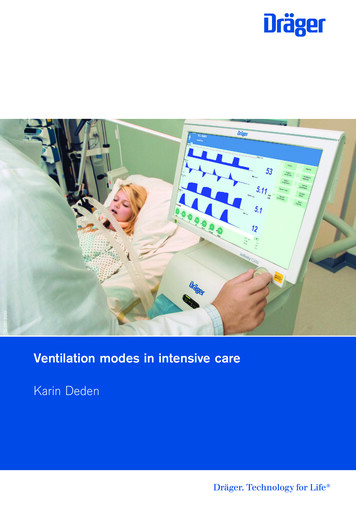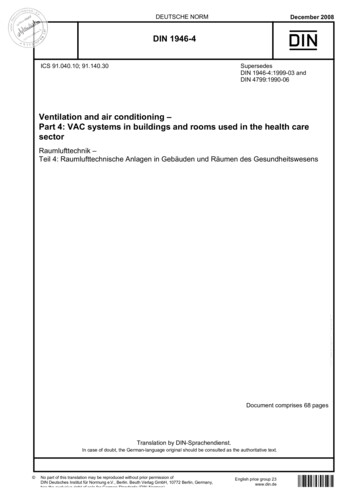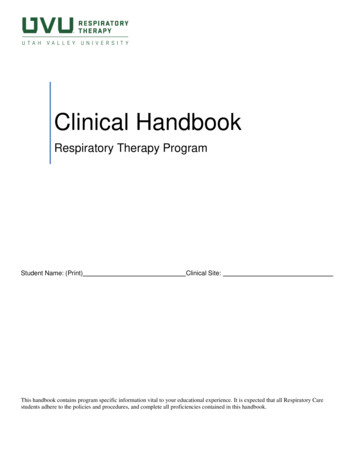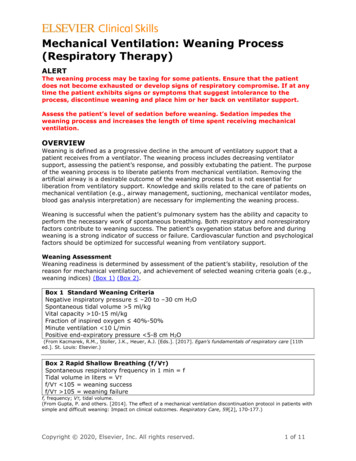
Transcription
Mechanical Ventilation: Weaning Process(Respiratory Therapy)ALERTThe weaning process may be taxing for some patients. Ensure that the patientdoes not become exhausted or develop signs of respiratory compromise. If at anytime the patient exhibits signs or symptoms that suggest intolerance to theprocess, discontinue weaning and place him or her back on ventilator support.Assess the patient’s level of sedation before weaning. Sedation impedes theweaning process and increases the length of time spent receiving mechanicalventilation.OVERVIEWWeaning is defined as a progressive decline in the amount of ventilatory support that apatient receives from a ventilator. The weaning process includes decreasing ventilatorsupport, assessing the patient’s response, and possibly extubating the patient. The purposeof the weaning process is to liberate patients from mechanical ventilation. Removing theartificial airway is a desirable outcome of the weaning process but is not essential forliberation from ventilatory support. Knowledge and skills related to the care of patients onmechanical ventilation (e.g., airway management, suctioning, mechanical ventilator modes,blood gas analysis interpretation) are necessary for implementing the weaning process.Weaning is successful when the patient’s pulmonary system has the ability and capacity toperform the necessary work of spontaneous breathing. Both respiratory and nonrespiratoryfactors contribute to weaning success. The patient’s oxygenation status before and duringweaning is a strong indicator of success or failure. Cardiovascular function and psychologicalfactors should be optimized for successful weaning from ventilatory support.Weaning AssessmentWeaning readiness is determined by assessment of the patient’s stability, resolution of thereason for mechanical ventilation, and achievement of selected weaning criteria goals (e.g.,weaning indices) (Box 1) (Box 2).Box 1 Standard Weaning CriteriaNegative inspiratory pressure –20 to –30 cm H2OSpontaneous tidal volume 5 ml/kgVital capacity 10-15 ml/kgFraction of inspired oxygen 40%-50%Minute ventilation 10 L/minPositive end-expiratory pressure 5-8 cm H2O(From Kacmarek, R.M., Stoller, J.K., Heuer, A.J. [Eds.]. [2017]. Egan’s fundamentals of respiratory care [11thed.]. St. Louis: Elsevier.)Box 2 Rapid Shallow Breathing (f/VT)Spontaneous respiratory frequency in 1 min fTidal volume in liters VTf/VT 105 weaning successf/VT 105 weaning failuref, frequency; VT, tidal volume.(From Gupta, P. and others. [2014]. The effect of a mechanical ventilation discontinuation protocol in patients withsimple and difficult weaning: Impact on clinical outcomes. Respiratory Care, 59[2], 170-177.)Copyright 2020, Elsevier, Inc. All rights reserved.1 of 11
Mechanical Ventilation: Weaning Process(Respiratory Therapy)Attention to other clinical factors is also important before initiating weaning trials. 2 Clinicaltools and checklists ensure systematic attention to these factors and may help ensure goodoutcomes (Box 3). In addition, prophylaxis regimens are recommended to preventcomplications in patients who are being mechanically ventilated. Complications includeventilator-associated pneumonia (VAP), deep vein thrombosis, gastrointestinal bleeding,and sinusitis.2Box 3 Burns Weaning Assessment Program (BWAP)*Patient namePatient history numberYesNoNotGeneral AssessmentAssessed1. Hemodynamically stable (pulse rate, cardiac output)?2. Free from factors that increase or decrease metabolicrate (seizures, temperature, sepsis, bacteremia,hypothyroid, hyperthyroid)?3. Hematocrit 25% (or baseline)?4. Systemically hydrated (weight at or near baseline,balanced intake and output)?5. Nourished (albumin 2.5, parenteral/enteral feedingsmaximized)? (If albumin is low and anasarca or thirdspacing is present, score for hydration should be “No.”)6. Electrolytes within normal limits (including Ca, Mg ,PO4)? Correct Ca for albumin level?7. Pain controlled? (subjective determination)8. Adequate sleep and rest? (subjective determination)9. Appropriate level of anxiety and nervousness?(subjective determination)10. Absence of bowel problems (diarrhea, constipation,ileus)?11. Improved general body strength and endurance (e.g.,out of bed in chair, progressive activity program)?12. Chest roentgenogram improving?Respiratory AssessmentGas Flow and Work of Breathing13. Eupneic respiratory rate and pattern (spontaneousrespiratory rate 25 breaths/min, without dyspnea,absence of accessory muscle use). This is assessed off theventilator while measuring #20-#23, below.14. Absence of adventitious breath sounds (rhonchi,crackles, wheezing)?15. Secretions thin and minimal?16. Absence of neuromuscular disease or deformity?17. Absence of abdominal distention, obesity, and ascites?18. Oral endotracheal tube 7.5 Fr or tracheostomy 6.0 FrAirway Clearance19. Cough and swallow reflexes adequate?Copyright 2020, Elsevier, Inc. All rights reserved.2 of 11
Mechanical Ventilation: Weaning Process(Respiratory Therapy)Strength20. Negative inspiratory pressure –20 cm H2O?21. Positive end-expiratory pressure 30 cm H2O?Endurance22. Spontaneous tidal volume 5 ml/kg?23. Vital capacity 10-15 ml/kg?Arterial Blood Gases24. pH 7.30-7.45?25. PaCO2 approximately 40 mm Hg (or baseline) withminute ventilation 10 L/min (evaluated while onventilator)?26. PaO2 60 mm Hg or FIO2 40%?*To score the BWAP: divide the number of “Yes” responses by 26.Ca, calcium; FIO2, fraction of inspired oxygen; Mg , magnesium; PaCO2, arterial partial pressure of carbon dioxide;PaO2, arterial partial pressure of oxygen; PO4, phosphate.(Copyright S.M. Burns, 1990.)The respiratory therapist (RT) remains with the patient, especially at the beginning of thetrial; makes assessments frequently during the trial; coaches the patient; reinforces thegoals and desired outcomes; and reminds the patient that successful weaning andextubation facilitate talking, eating, self-care activities, and mobilization.2Weaning indices have proven to be disappointing predictors of a patient’s ability to wean.2Most predictors focus on pulmonary-specific factors. In general, the indices are poor positivepredictors (they do not indicate that the patient will wean), but they are good negativepredictors (they indicate that the patient will not wean). Thus, use of the indices is notwidespread. The various weaning indices are best used to evaluate the components fromwhich they are designed (breathing pattern, respiratory muscle strength, etc.). Theseindices, if measured, are generally measured by the RT.The patient’s overall status should be optimized before weaning of the ventilatory support isattempted. In addition to respiratory condition, assessment of weaning readiness shouldinclude acid-base status, electrolyte balance, status of other organ systems, nutritionalstatus, and psychological state.Signs of Intolerance or FailureDuring weaning, the patient should be continuously monitored for respiratory distress. Nosingle symptom defines failure. Patients should be monitored for: Increased work of breathing (nasal flaring, use of accessory muscles, paradoxical chestmovements, retractions) Crackles or wheezing on auscultation Oxygen saturation Changes in mental status Blood pressure Heart rate Cardiac arrhythmias Respiratory rate Tidal volume (VT) Minute volume (MV)Copyright 2020, Elsevier, Inc. All rights reserved.3 of 11
Mechanical Ventilation: Weaning Process(Respiratory Therapy) Change in end-tidal carbon dioxide (ETCO2) levelWeaning Trial ProtocolsProtocol-directed spontaneous breathing trials (SBTs) can reduce ventilator duration. Whencombined with aggressive sedation management, they may also reduce intensive care unitlength of stay, hospital length of stay, and mortality. Protocol-directed multidisciplinaryweaning using weaning screens and short-duration SBTs are superior to individualizedweaning processes,2 although acceptance of and adherence to protocols may be low. Theuse of the protocols decreases practice variation, which may be the major reason for theireffectiveness. Key to a protocol’s success is the use of the weaning screen, which requiresthat a minimum of clinical factor thresholds (e.g., hemodynamic stability, fraction ofinspired oxygen [FIO2], and positive end-expiratory pressure [PEEP] level) are met.2Screening ensures early and aggressive testing of the patient’s readiness. Once the screenis passed, the patient is placed on an SBT for a short duration before extubation. If signs ofintolerance emerge, the patient is returned to ventilatory support and a trial is reattemptedat a later time as predetermined by the protocol.Methods for WeaningSBTs appear to be the best method;2 most of these methods employ breathing through a Tpiece or on the ventilator (with or without the addition of continuous positive airwaypressure [CPAP], low respiratory rates on synchronized intermittent mechanical ventilation[SIMV], or other flow mechanisms, such as automatic tube compensation). Other modes,such as pressure-support ventilation (PSV), may be equally as effective.Respiratory Muscle Fatigue, Work, Rest, and ConditioningDuring the weaning process, prevention of respiratory muscle fatigue must be considered.All muscles may fatigue if work exceeds energy stores. Signs and symptoms of impendingfatigue include dyspnea, tachypnea, chest-abdominal asynchrony, and increasing arterialpartial pressure of carbon dioxide (PaCO2), which is a late sign. Generally, avoidingpremature or excessively long or difficult weaning trials can prevent fatigue.The concepts of work, rest, and conditioning are useful to consider when selecting weaningmodes and methods. A higher respiratory workload is similar to strength training, and lowpressure, high-volume work is similar to endurance conditioning. These two methods ofmuscle conditioning apply to the respiratory muscles as well as other muscle groups withinthe body:1. A higher respiratory workload is associated with the use of a T-piece and CPAP, with lowintermittent mandatory ventilation (IMV) rates. Generally, any method that requires thepatient to breathe spontaneously (without inspiratory support) results in high-pressure, lowvolume work. Conditioning episodes are generally of short duration, with full muscle restbetween episodes.2. Low-pressure, high-volume work is found with the use of PSV, in which inspiration isaugmented. For any given pressure level, workload is less than if the patient were breathingspontaneously. At high levels of PSV, little work occurs, but as the level is reduced, muscleworkload increases.With both types of conditioning, the goal is to progress through the trials without inducingfatigue. To that end, rest is that level of ventilatory support that unloads the respiratoryCopyright 2020, Elsevier, Inc. All rights reserved.4 of 11
Mechanical Ventilation: Weaning Process(Respiratory Therapy)muscles. The level of support needed may differ with each patient; however, two basicconcepts may be useful:1. When signs of intolerance emerge, the trial is stopped and the patient is rested.2. Application of rest varies with the weaning mode. For example, if the mode is PSV, thenthe PSV is increased to the level required to decrease the spontaneous rate to a respiratoryrate within a normal range and the result is a synchronous, comfortable breathing pattern.With high-pressure, low-volume modes such as CPAP, the patient is returned to fullventilatory support.Multidisciplinary ApproachesA plan for weaning is determined by the multidisciplinary team and is applied and monitoredcarefully. The plan, whether it employs a protocol or consists of a more individualized plan,should be available to all health care professionals involved in the weaning process.Assessment of weaning potential may include checklists of factors important to weaning,such as the Burns Weaning Assessment Program (Box 3). In addition, prophylaxis for VAPand other potential complications associated with mechanical ventilation must beconsidered.EDUCATION Explain the steps of weaning and why weaning is being initiated.Reassure the patient of the RT’s presence during initiation of weaning.Discuss the sensations the patient may experience, such as smaller ventilator-assistedbreaths, dyspnea, and change or absence of ventilator sounds; explain that weaningtrials are a form of conditioning and do require effort. Some dyspnea is to be expected.Encourage the patient to relax and breathe comfortably.Assure the patient and family that rapid return to ventilatory support will beaccomplished if the patient becomes excessively dyspneic, becomes anxious, or exhibitsnegative physiologic changes (e.g., desaturation; blood pressure or heart rate or rhythmchanges; diaphoresis).Encourage questions and answer them as they arise.ASSESSMENT AND PREPARATIONAssessment1. Perform hand hygiene before patient contact.2. Introduce yourself to the patient.3. Verify the correct patient using two identifiers.4. Regularly evaluate factors that impede weaning in conjunction with factors that measurerespiratory muscle strength, endurance, and gas exchange (Box 1) (Box 2) (Box 3).5. Frequently assess the patient’s progress toward achievement of individual short-termgoals.6. In patients who require mechanical ventilation for very long times (and may require atracheostomy), assess daily progress toward achievement of individual long-term goalsin collaboration with the practitioner, nurse, patient, and family, as appropriate.7. Assess changes in level of consciousness or nonverbal behavior and complaints ofdyspnea or fatigue.8. Assess arterial blood gas (ABG) values as needed.9. Assess partial pressure of ETCO2 levels.Copyright 2020, Elsevier, Inc. All rights reserved.5 of 11
Mechanical Ventilation: Weaning Process(Respiratory Therapy)10. Assess oxygenation indices (arterial oxygen saturation [SaO2] or arterial partial pressureof oxygen [PaO2]) during trials.11. Assess the patient’s anxiety level.12. Evaluate the patient’s stability and overall condition before initiating active weaningtrials.Rationale: Premature weaning attempts may be harmful and frustrating for allinvolved. A multidisciplinary team approach ensures active attention to thediverse factors that affect weaning readiness (Box 1) (Box 2) (Box 3).Preparation1. Ensure that the patient understands preprocedural weaning instruction.2. Address all factors that may impede weaning potential.a. Factors include pH level, hemodynamic stability, electrolytes, strength, endurance,mobility, nutrition, and fluid status.b. A systematic approach using a checklist helps avoid variation in practice.3. Establish weaning screen criteria, if applicable.4. Determine the duration of the weaning trial before beginning.PROCEDURET-Piece or Tracheostomy Collar Trials1. Perform hand hygiene and don gloves. For patients with isolation precautions, also don agown, mask, and eye protection.2. Verify the correct patient using two identifiers.3. Explain the procedure to the patient and ensure that he or she agrees to treatment.4. Position the patient for optimum ventilation. Positions for optimum ventilation vary, butmost patients should be positioned with the head of the bed elevated 30 degrees orhigher.15. Communicate with the patient and family throughout the weaning process.6. Suction the artificial airway to ensure patency.7. Connect the patient to a heated aerosol via a T-piece or tracheostomy collar.Rationale: Heated aerosol replaces water, which normally is added by theupper airway when it is not bypassed by an endotracheal or a tracheostomytube.8. Inform the patient that the trial will feel different than when on the ventilator andinstruct him or her to try to breathe normally.9. Monitor the patient’s respiratory frequency, breathing pattern, heart rate and rhythm,SaO2, and general appearance.Rationale: Signs and symptoms of tolerance must be heeded to preventrespiratory muscle fatigue.Closely tend to the patient because the T-piece and tracheostomycollar have no alarms for apnea or hypoventilation.Copyright 2020, Elsevier, Inc. All rights reserved.6 of 11
Mechanical Ventilation: Weaning Process(Respiratory Therapy)10. After a predetermined time interval or with the emergence of signs of intolerance, placethe patient back on resting ventilator settings.Do not exceed the predetermined duration of the weaning trial.Rationale: Adequate rest between trials and at night offsets fatigue andencourages effective respiratory muscle conditioning. The patient is placedback on the ventilator to rest until all data regarding weaning response can beassessed.11. If the patient successfully meets full trial criteria, notify the practitioner and teamregarding the patient’s response, and consider extubation. If a protocol is in place,extubation may be the next step and may not require such notification.12. Discard supplies, remove personal protective equipment (PPE), and perform handhygiene.13. Document the procedure in the patient’s record.CPAP Trials1. Perform hand hygiene and don gloves. For patients with isolation precautions, also don agown, mask, and eye protection.2. Verify the correct patient using two identifiers.3. Explain the procedure to the patient and ensure that he or she agrees to treatment.4. Position the patient for optimum ventilation. Positions for optimum ventilation vary, butmost patients should be positioned with the head of the bed elevated 30 degrees orhigher.15. Communicate with the patient and family throughout the weaning process.6. Suction the artificial airway to ensure patency.7. Change the patient from resting ventilatory settings to CPAP.Rationale: An advantage of CPAP over T-piece trials is that VT and respiratoryrate are monitored easily throughout the trial by the ventilator. The RT canset alarms with a CPAP trial.8. Instruct the patient to breathe normally and monitor for signs and symptoms ofintolerance. If using a protocol, refer to specific criteria.Rationale: As with the T-piece, this method employs high-pressure, lowvolume work. Prompt return to the ventilator is necessary to preventexcessive work and fatigue.9. After a predetermined time interval on CPAP or with signs or symptoms of intolerance,place the patient back on resting ventilator settings.Do not exceed the predetermined duration of the weaning trial.Rationale: Adequate rest between trials and at night offsets fatigue andencourages effective respiratory muscle conditioning. The patient is placedback on the ventilator to rest until all data regarding the weaning responsecan be assessed.Copyright 2020, Elsevier, Inc. All rights reserved.7 of 11
Mechanical Ventilation: Weaning Process(Respiratory Therapy)10. Notify the team of the results of trials. If the last step of the weaning plan or protocolhas been attained, consider extubation. If a protocol is used, this step may beautomatic.11. Discard supplies, remove PPE, and perform hand hygiene.12. Document the procedure in the patient’s record.SIMV Weaning Method1. Perform hand hygiene and don gloves. For patients with isolation precautions, also don agown, mask, and eye protection.2. Verify the correct patient using two identifiers.3. Explain the procedure to the patient and ensure that he or she agrees to treatment.4. Position the patient for optimum ventilation. Positions for optimum ventilation vary, butmost patients should be positioned with the head of the bed elevated 30 degrees orhigher.15. Communicate with the patient and family throughout the weaning process.6. Suction the artificial airway to ensure patency.7. Gradually and progressively decrease SIMV breaths.Rationale: This method of weaning provides a gradual reduction of ventilatorsupport. The preset breaths are progressively decreased as the patientassumes a greater proportion of the minute volume with spontaneousbreathing.2Some IMV and SIMV demand valves offer high resistance tospontaneous breathing. Work of breathing may be greatly increasedand cause fatigue, especially at low IMV rates. To avoid this, add PSV.a. PSV is commonly used between IMV breaths to offset the work associated with smalltube sizes, circuit resistance, and high breathing rates.b. The method has largely been replaced with SBTs, using a T-piece or CPAP, because theyare easier to accomplish.c. If SIMV is used, have a plan in place for progressive weaning and predetermine a clinicalend point. A plan that clearly describes the end point of this method is essential.8. Assess the patient for the signs and symptoms of fatigue, inadequate gas exchange, andimpaired breathing pattern with decreases in the SIMV rate.Lower levels of IMV, when not used with PSV, are similar to strengthconditioning trials. Ensure adequate rest times between trials and atnight.9. Notify the team of the results of trials. If the last step of the weaning plan or protocolhas been attained, consider extubation. If a protocol is used, this step may beautomatic.10. Discard supplies, remove PPE, and perform hand hygiene.11. Document the procedure in the patient’s record.Copyright 2020, Elsevier, Inc. All rights reserved.8 of 11
Mechanical Ventilation: Weaning Process(Respiratory Therapy)PSV Weaning Method1. Perform hand hygiene and don gloves. For patients with isolation precautions, also don agown, mask, and eye protection.2. Verify the correct patient using two identifiers.3. Explain the procedure to the patient and ensure that he or she agrees to treatment.4. Position the patient for optimum ventilation. Positions for optimum ventilation vary, butmost patients should be positioned with the head of the bed elevated 30 degrees orhigher.15. Communicate with the patient and family throughout the weaning process.6. Suction the artificial airway to ensure patency.7. Set the PSV level at maximum (PSV max) and decrease the level according to theorganization’s practice or as clinically indicated (e.g., no signs of intolerance).Rationale: PSV max is the level that attains the absence of increased work ofbreathing and allows for suitable VT according to the patient’s demand. Higherrespiratory rates and smaller VT values are generally acceptable during trials.Full support should be ensured at night and for rest, especially early in theweaning process.Be cautious when using high levels of PSV with patients who haveobstructive lung conditions because the higher levels may promoteoverdistention and air trapping.8. Monitor the patient’s responses to weaning. Return the patient to full ventilatory supportif signs of intolerance occur and when the intended duration of trial has been reached.Rationale: PSV, despite requiring spontaneous effort, reduces the work ofbreathing associated with circuits, endotracheal tubes, and high breathingrates. However, fatigue is possible if the level is not appropriately set.Alternately, PSV can provide relief and rest to the respiratory muscles.9. When the clinical goal for PSV weaning is accomplished, discuss extubation with thepractitioner. If a protocol is used, the next step may be automatic.10. Discard supplies, remove PPE, and perform hand hygiene.11. Document the procedure in the patient’s record.MONITORING AND CARE1. Evaluate the patient for signs and symptoms of intolerance and respiratory musclefatigue. If signs of intolerance occur, promptly return the patient to supportedventilation.a. Frequency of evaluation may vary depending on how long the patient has been on theventilator and the patient’s stability.b. A multidisciplinary approach is encouraged.Hemodynamic instability should result in a return to ventilatorysupport until the patient is stable.c. Continuous ETCO2 monitoring should be done if available.Copyright 2020, Elsevier, Inc. All rights reserved.9 of 11
Mechanical Ventilation: Weaning Process(Respiratory Therapy)2. Observe the patient for signs or symptoms of pain. If pain is suspected, report it to theauthorized practitioner.EXPECTED OUTCOMES Timely and successful discontinuance of mechanical ventilationComfortable and adequate breathing pattern during the weaning processUNEXPECTED OUTCOMES Tracheal injuryPulmonary barotraumaCardiovascular essful weaning trialsInadvertent extubationDOCUMENTATION Patient and family educationIndividualized goals for weaningProcedure used for weaning (e.g., T-piece, decreasing IMV or SIMV support, PSV, flowby PEEP, or CPAP)Parameters used to assess patient readiness to wean and weaning trial tolerance,including clinical indicatorsPatient response to decrements in mechanical ventilation supportMode or method of weaningDuration of trialLevel of support (if appropriate, as in PSV, flow-by PEEP, or CPAP)Unexpected outcomes and related interventionsREFERENCES1. Altobelli, N. (2017). Chapter 36: Airway management. In R.M. Kacmarek, J.K. Stoller,A.J. Heuer (Eds.), Egan’s fundamentals of respiratory care (11th ed., pp. 739-789). St.Louis: Elsevier.2. Gupta, P. and others. (2014). The effect of a mechanical ventilation discontinuationprotocol in patients with simple and difficult weaning: Impact on clinical outcomes.Respiratory Care, 59(2), 170-177. doi:10.4187/respcare.02558 (Level IV)ADDITIONAL READINGSAzeredo, L.M. and others. (2016). The integrative weaning index in elderly ICU subjects.Respiratory Care, respcare.04524. Epub ahead of print. doi:10.4187/respcare.04524Holets, S.R., Marini, J.J. (2016). Is automated weaning superior to manual spontaneousbreathing trials? Respiratory Care, 61(6), 749-760. doi:10.4187/respcare.04329Kacmarek, R.M. (2017). Chapter 52: Discontinuing ventilatory support. In R.M. Kacmarek,J.K. Stoller, A.J. Heuer (Eds.), Egan's fundamentals of respiratory care (11th ed., pp.1190-1215). St. Louis: Elsevier.Copyright 2020, Elsevier, Inc. All rights reserved.10 of 11
Mechanical Ventilation: Weaning Process(Respiratory Therapy)Lu, Z. and others. (2016). Diaphragmatic dysfunction is characterized by increased durationof mechanical ventilation in subjects with prolonged weaning. Respiratory Care, 61(10),1316-1322. doi:10.4187/respcare.04746Piraino, T. (2017). Chapter 51: Monitoring the patient in the intensive care unit. In R.M.Kacmarek, J.K. Stoller, A.J. Heuer (Eds.), Egan’s fundamentals of respiratory care (11thed., 1154-1189). St. Louis: Elsevier.Sklar, M.C. and others. (2016). Effort to breathe with various spontaneous breathing trialtechniques. A physiological meta-analysis. American Journal of Respiratory and CriticalCare Medicine, Oct 21. Epub ahead of print.Elsevier Skills Levels of Evidence Level I - Systematic review of all relevant randomized controlled trials Level II - At least one well-designed randomized controlled trial Level III - Well-designed controlled trials without randomization Level IV - Well-designed case-controlled or cohort studies Level V - Descriptive or qualitative studies Level VI - Single descriptive or qualitative study Level VII - Authority opinion or expert committee reportsSupplies Digital readout of VT and respiratory rateSpirometerIf T-piece or tracheostomy collar setup is required: flow meter with functional heatedaerosol humidifier (with inline thermometer and water trap)Tracheostomy collar or T-piece adaptersPPE (gloves, mask, eye protection, gown)Pressure manometersWeaning protocol or weaning planExtubation equipmentSuctioning equipmentClinical Review: Christine J. Moore, DHSc, NPS-RRT, CPFTPublished: October 2019Copyright 2020, Elsevier, Inc. All rights reserved.11 of 11
A higher respiratory workload is similar to strength training, and low-pressure, high-volume work is similar to endurance conditioning. These two methods of muscle conditioning apply to the respiratory muscles as well as other muscle groups within the body: 1. A higher respiratory workload is associated with the use of a T-piece and CPAP, with low
